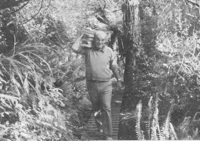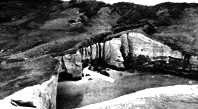Cape Saunders Lighthouse and the grave of the two children.
“Cape Saunders on the Otago Peninsula, was named by Captain James Cook after Sir Charles Saunders, the First Lord of the Admiralty, the commander of the fleet which captured Quebec in 1759.
Early shipping into the town of Dunedin via Port Chalmers was hindered because of the lack of lighthouses marking the harbour on the peninsula so often ships arriving from England sailed past the harbour entrance and headed further north. It was not uncommon during the 1850s for ships to spend days searching for the harbour entrance and the Otago Provincial Council recognized the importance of lights so in 1863 appointed James Balfour as Provincial Marine Engineer. It was not before time as in 1860 only 60 vessels had arrived at the port but by 1863 this had increased to 983.
Balfour arrived from Scotland later in 1863 with both the lantern forTaiaroa Head and Cape Saunders (the lanterns from Scotland and lens from France respectably). He immediately set to work designing his first lighthouse for the council at Taiaroa Head and this light was lit on 2 January, 1865. The original light was red to distinguish itself from the proposed light at Cape Saunders.
Meanwhile the Otago Provincial Council had begun planning the lighthouse at Cape Saunders, buying land off the local Maori at a place called Kaimata in 1862 but a lack of funds halted the project.
So the Provincial Government erected a 12 foot white stone beacon on the Cape in 1868. But this proved to be totally inadequate for the job as ships often steamed pass the harbour entrance not having seen the beacon.
The Otago Daily Times was to report on January 13 1865, that the Cape Saunders Light apparatus was displayed at the first New Zealand Exhibition in Dunedin.
After the Marine Board was formed in 1862, James Balfour was appointed Colonial Marine Engineer in 1866 when this board was changed to the Marine Department.
By now the light equipment for Cape Saunders was still idle so it was used at Nugget Point which was lit in 1870.
In 1875, the Marine Department led by John Blackett and Captain Johnson, decided to build a new light at nearby Matakitaki Point which had easier access and was not so exposed to fog. This 28 foot wooden tower similar in design to Akaroa was constructed in 1878 and the light was first lit on 1 January, 1880.
The first Head Keeper was James Nelson, who was transferred from The Brothers lighthouse.
Tragedy was to plague the lighthouse in it’s first few years. In December 1882 Mr. Nelson’s wife died suddenly. As the youngest child of the family was only 20 months old, the Marine Department granted the keepers request to transfer out of the Department into the Customs Department. But before he was transferred on March 19, 1883, the two year old daughter of the Assistant Keeper (Patrick Henaghan) and the youngest child of the Mr. Nelson died when the cow shed they were playing in caught fire. Later another child died of illness and six months later, the son of the new Head Keeper fell over the cliff and broke his wrist.
The wooden tower was replaced in 1954 by a steel latticework tower and a new mains powered electric beacon. However, this tower didn’t last due to salt water corrosion and was replaced again in 1967 with the old lantern room from Kaipara Lighthouse.
The light was fully automated in April 1980.
In June of 2006, the lighthouse was again replaced, this time with a modern aluminum tower. The backup diesel generator was removed and new battery pack was installed to supply backup power if the mains power fails.
The old Kaipara Head lantern room has been sent back to Kaipara where it will be restored.
The lens and lighting equipment is displayed at the Port Chalmers Museum.
DIRECTIONS:
Situated on the Otago Peninsula. Currently a restricted area on private land.
A modern aluminum tower is now in use.
– Extracted from NEW ZEALAND LIGHTHOUSES, Cape Saunders (1880) NZ Lighthouses Text and photographs. Copyright © 1999-2009 Mark Phillips. All rights reserved.


